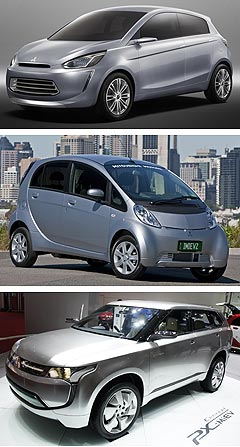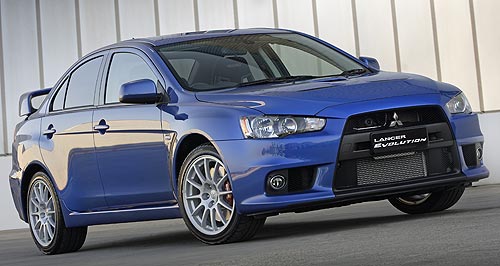Future models - Mitsubishi - Lancer - EvolutionMitsubishi's Lancer Evo not dead after allAin't dead yet: Lancer Evo still has a pulse as Mitsubishi claim European reports of its demise are greatly exaggerated. Mitsubishi refutes reports its iconic Lancer Evo rally rocket will be killed off4 Mar 2011 MITSUBISHI has fired back at a European report claiming it will discontinue its legendary Lancer Evolution road rocket, on which its treasured rally heritage is built. “Production of the current Lancer Evolution continues as planned,” said Mitsubishi Motors Corporation in a statement issued in Japan today. “As for its successor, regulations and market feedback will dictate its engineering package and architecture.” The statement appears to confirm there will indeed be a successor for the current Lancer Evo X, but suggests the Evo XI will take a radical new technology approach to the turbocharged all-wheel drive version available today. It also backs up previous reports that state development of the next-generation Evo has stalled while Mitsubishi assesses the engineering direction of the all-new model, which could include the same plug-in hybrid drive system that debuted beneath last year’s PX-MiEV crossover concept. While the PX-MiEV itself is expected to morph into the next-generation Outlander SUV and has been confirmed for global release (including in Australia) in 2013, as the first of eight new all-electric or plug-in hybrid models from the brand by 2015 – by which time Mitsubishi hopes to reduce its fleet CO2 average by 25 per cent compared with 2005 levels. The PX-MiEV powers both its front and rear wheels with a two 60kW permanent magnet synchronous motors, while a 1.6-litre MIVEC petrol engine also drives the front wheels as well as acting as a generator.  From top: Mitsubishi 'Global Small' from 2011 Geneva show, Mitsubishi i-MiEV and Mitsubishi PX-MiEV. From top: Mitsubishi 'Global Small' from 2011 Geneva show, Mitsubishi i-MiEV and Mitsubishi PX-MiEV.The system is configured around Mitsubishi’s Evo-style S-AWC handling control system and automatically switches between different drive modes depending demand and remaining power in the lithium ion battery pack. Effectively i-MiEV electric technology for the rear wheels while adding a parallel hybrid system for the front wheels, the sophisticated switchable system could easily be adapted for the new lancer, which will be based on the redesigned Lancer due on sale within a few years. Word of the Evo’s demise was first reported by Autocar, which quoted Mitsubishi’s global product director Gayu Eusegi at this week’s Geneva motor show as saying: “There is still a demand (for the Evo), but we must stop. “Our influence now is EV technology,” said Mr Eusegi, who when asked if the current Evo would be the last replied: “Yes. Maybe the world can change and maybe someday we can do a motor race by electric vehicles. Maybe then we can enter the market again.” Far from confirming the current Evo will be the last, MMC’s subsequent statement this week seems to confirm the current Evo will only be the last of its type. There has been no major upgrade to the Evo since the 10th-generation model went on sale in Japan in 2007, and it now appears likely its replacement will not employ the conventional turbocharged petrol engine and differential-based drivetrain technology that has been its hallmark for almost two decades. Prior to MMC’s official statement, Mitsubishi Motors Australia vice-president of customer and brand management Paul Unerkov yesterday told GoAuto it had received no information about a replacement for the next Evo. “I know what you know – nothing has been confirmed,” said Mr Unerkov. “EV technology is important to Mitsubishi and will be a key part of our strategy in future, but we won’t have a definitive answer (on the next Evo) until the next Lancer arrives.” Mr Unerkov would not be drawn on which of the eight new EV or plug-in hybrid models Mitsubishi has committed to producing by 2015 will be sold in Australia – beyond the PX-MiEV/Outlander – but said a successor for its under-performing Colt would become available here in the third quarter of next year. “Global Small combines the fuel-efficiency of an A (segment) car with the performance of a B-car and we think the (sub-light) A-segment will grow significantly in coming years,” he said. “It’s a great opportunity in a segment we’re not competitive in now – a very important part of the Australian market,” he said. Due to commence production in Thailand in early 2012, Mitsubishi’s all-new ‘Global Small Car’ made its world debut at this week’s Geneva motor show, where Mitsubishi confirmed 1.0 and 1.2-litre petrol versions will be joined by an all-electric derivative. “We’d like a petrol, diesel and some sort of electric or plug-in hybrid version of every model in our range,” said Mr Unerkov. “There will be a mix depending on market requirements – consumers will determine whether it’s pure EV or plug-in hybrid. The goal is to marry each application with the most suitable technology. “That’s consistent with the mid-term plan we announced a month ago and that’s where all of the company’s resources are focussed right now.” Beyond releasing its pioneering lease-only i-MiEV for public sale in the third quarter of this year Down Under, in the long-term Mitsubishi also plans to produce a sedan version of the Global Small hatchback and a joint-venture light commercial van based on Nissan’s new NV200 to replace the aged Express van.  Read moreAll future models Alfa Romeo Alfa Romeo Abarth Abarth Audi Audi Aston Martin Aston Martin BMW BMW Bentley Bentley Chrysler Chrysler Chevrolet Chevrolet Dodge Dodge Citroen Citroen Ferrari Ferrari DS DS Ford Ford Fiat Fiat FPV FPV Foton Foton Haval Haval Great Wall Great Wall Honda Honda Holden Holden Hyundai Hyundai HSV HSV Isuzu Isuzu Infiniti Infiniti Jeep Jeep Jaguar Jaguar Lamborghini Lamborghini Kia Kia Lexus Lexus Land Rover Land Rover Mazda Mazda Maserati Maserati Mercedes-Benz Mercedes-Benz McLaren McLaren Mini Mini Nissan Nissan Mitsubishi Mitsubishi Peugeot Peugeot Opel Opel Proton Proton Porsche Porsche Renault Renault Ram Ram Saab Saab Rolls-Royce Rolls-Royce Smart Smart Skoda Skoda Subaru Subaru SsangYong SsangYong Tesla Tesla Suzuki Suzuki Toyota Toyota Volvo VolvoLancer pricingMotor industry news |
Click to shareMitsubishi modelsAll future models Alfa Romeo Alfa Romeo Abarth Abarth Audi Audi Aston Martin Aston Martin BMW BMW Bentley Bentley Chrysler Chrysler Chevrolet Chevrolet Dodge Dodge Citroen Citroen Ferrari Ferrari DS DS Ford Ford Fiat Fiat FPV FPV Foton Foton Haval Haval Great Wall Great Wall Honda Honda Holden Holden Hyundai Hyundai HSV HSV Isuzu Isuzu Infiniti Infiniti Jeep Jeep Jaguar Jaguar Lamborghini Lamborghini Kia Kia Lexus Lexus Land Rover Land Rover Mazda Mazda Maserati Maserati Mercedes-Benz Mercedes-Benz McLaren McLaren Mini Mini Nissan Nissan Mitsubishi Mitsubishi Peugeot Peugeot Opel Opel Proton Proton Porsche Porsche Renault Renault Ram Ram Saab Saab Rolls-Royce Rolls-Royce Smart Smart Skoda Skoda Subaru Subaru SsangYong SsangYong Tesla Tesla Suzuki Suzuki Toyota Toyota Volvo VolvoLancer pricingMotor industry news |
















Facebook Twitter Instagram